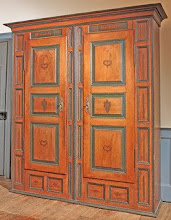As mentioned in our most recent column (but perhaps more relevant to our "
A Field Guide to Collectors" column), the Collyer Brothers are fascinating. They just are. It's one of those tabloid stories that you feel guilty for being intrigued by, but you just can't look away! Homer (1881 to 1947) and Langley Collyer (1885 to 1947) have become synonymous with complusive hoarding, and their Harlem brownstone set a benchmark for filth and disarray that would seem impossible to surpass. Sons of a prominent Manhattan doctor, the boys were both educated at Columbia University and were well-known for their eccentricities early in life. Their father abandoned the family in the late 1910s, and both their father and mother had passed away by 1929.
This is the point at which things really seem to venture off the beaten path. The Collyers moved their inherited possessions into their Harlem home and retreated even further into their odd and reclusive lifestyle. Of course, the attention their behavior drew only created more problems for them, providing fodder for their blossoming paranoia. Rumors about the house and its contents abounded, so of course, it became a target for burglars, thugs and teenage boys trying to prove their bravery. The Collyer brothers responded with the full force of their mental illness, boarding up the house, laying booby traps for potential invaders, and severing virtually all ties with the outside world.
By the end of the 1930s, all utilities to the house had been shut off due to lack of payment, and Homer Collyer had gone blind from health complications. Langley continued to venture all over the city, dragging home junk, often under cover of darkness. Little was seen or heard from them until the local police received an anonymous tip on March 21, 1947 that there was a dead body in the house. The sheer mass of the Collyers' junk stymied the initial efforts of the police to investigate, but eventually, they were able to gain access to a room on the second floor. After two hours of searching, Homer Collyer's body was discovered, but he was clearly not the source of the stench of decomposition, being dead only a few hours.
As impossible as it seems, it took police more than two weeks to locate the body of Langley Collyer in the house, a mere ten feet away from where his brother's body had been discovered. Tragically, Langley had fallen victim to one of his own booby traps, leaving Homer to starve, too blind and incapacitated to escape.
Among the items removed from the Collyer house, aside from mountains of newspapers and books, were fourteen pianos, a Model T chassis, pickled human organs, and the folding top of a horse-drawn carriage. This photograph, from the collection of the New York Public Library via Wikipedia, offers a sense of the sheer volume of "stuff" that had to be cleared away.

For more information, check out Wikipedia's article on the
Collyer Brothers and Franz Lidz's
New York Times article, "
The Paper Chase," from Oct. 26, 2003.







